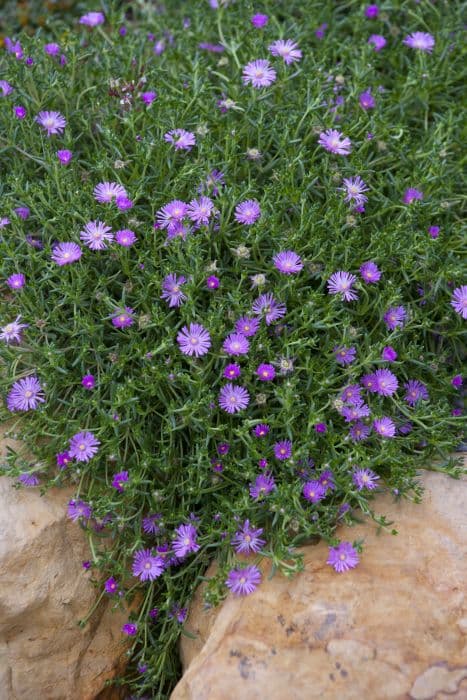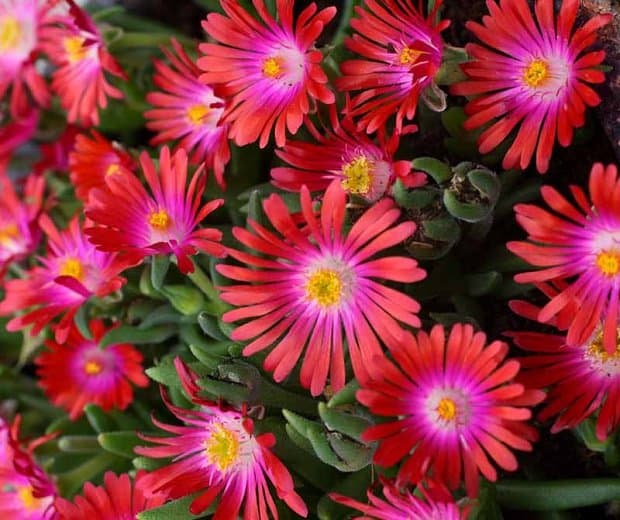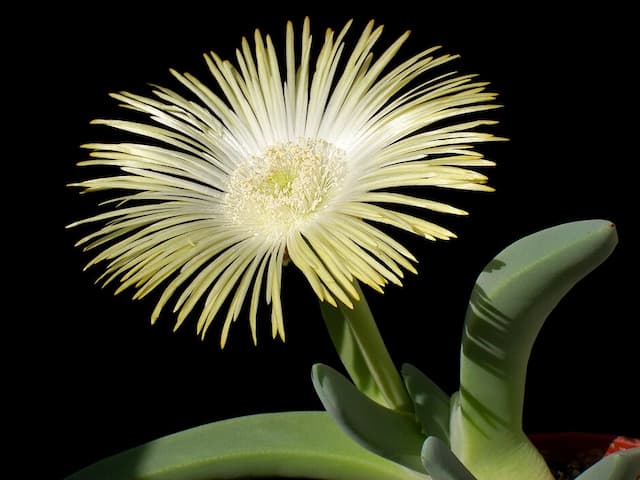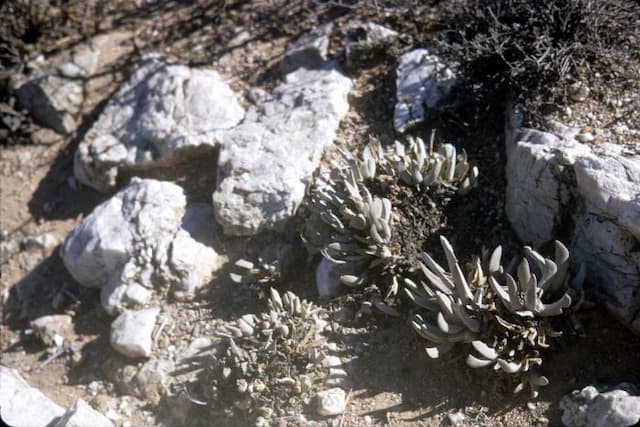Trailing Ice Plant Delosperma 'John Proffitt'

ABOUT
Delosperma 'John Proffitt', commonly known as Table Mountain Ice Plant, is a creeping, mat-forming succulent perennial characterized by its vibrant and profuse daisy-like flowers. The blossoms are typically a vivid fuchsia or magenta with a white center that gleams against the backdrop of the plant's foliage. These blooms are known for their shimmering, iridescent quality that catches the light, making them particularly eye-catching. Radiating from the center of each flower are delicate, narrow petals that often exhibit a glistening sheen. The foliage of Table Mountain Ice Plant is equally distinctive, composed of small, fleshy, cylindrical leaves that are tightly packed along the spreading stems. These leaves are a rich, jade green color, sometimes bearing a slightly bluish tint, and have a glossy, succulent texture. When looked at closely, one may notice that the leaves can have a slight translucence, contributing to the plant's overall lush and vibrant appearance. The combination of the dazzling flowers and the lush leaves creates a striking contrast that is both colorful and texturally diverse. Together, the floriferous display and succulent foliage of the Table Mountain Ice Plant form a dense, carpet-like ground cover. This plant is often praised for its hardiness and its ability to provide long-lasting, vibrant color in garden settings, especially when it spreads across rocky areas or cascades down slopes, creating a wave of intense color. Overall, the visual appeal of Delosperma 'John Proffitt' lies in its vivid blooms, succulent leaves, and its sprawling habit that densely covers the ground with a riot of color.
About this plant
 Names
NamesFamily
Aizoaceae
Synonyms
Trailing Ice Plant, Table Mountain Ice Plant, Hardy Ice Plant
Common names
Delosperma 'John Proffitt'.
 Toxicity
ToxicityTo humans
The Delosperma 'John Proffitt', commonly known as Ice Plant, is not reported to be toxic to humans. Ingesting this plant should not cause poisoning or adverse symptoms. However, as with any plant material, individual allergies or sensitivities could result in mild stomach upset or irritation if ingested in large quantities. It's generally advisable to avoid eating ornamental plants.
To pets
The Ice Plant, specifically Delosperma 'John Proffitt', is also not known to be toxic to pets. It should not pose a significant risk of poisoning if pets happen to ingest small quantities of the plant. Nonetheless, pet owners should monitor their animals to prevent them from eating large amounts of plant material since it could potentially cause digestive upset or an obstruction in some cases.
 Characteristics
CharacteristicsLife cycle
Perennials
Foliage type
Evergreen
Color of leaves
Green
Flower color
Pink
Height
0.25 feet (7.62 cm)
Spread
2 feet (60.96 cm)
Plant type
Succulent
Hardiness zones
6
Native area
South Africa
Benefits
 General Benefits
General Benefits- Drought Tolerant: Delosperma 'John Proffitt', commonly known as Trailing Ice Plant, is highly resilient in dry conditions once established, making it suitable for xeriscaping.
- Easy to Grow: It is a low-maintenance plant that requires minimal care, making it ideal for novice gardeners or those with limited time.
- Attracts Pollinators: The vibrant flowers of the Trailing Ice Plant attract bees and butterflies, which are essential for pollinating other plants.
- Ground Cover: Its spreading habit makes it a good choice for ground cover, helping to suppress weeds and reduce soil erosion.
- Long Blooming Season: The plant has a lengthy blooming period that extends from spring to fall, providing extended garden interest.
- Colorful Flowers: The Trailing Ice Plant produces abundant, brightly colored daisy-like flowers, which can enhance the aesthetic appeal of any garden space.
- Cold Tolerant: It can survive in colder temperatures and is hardy in many growing zones, ensuring year-round presence in the landscape.
- Soil Adaptability: This plant can thrive in a variety of soil types, including poor or sandy soils, as long as they are well-drained.
- Deer Resistant: The foliage and flowers are not preferred by deer, making it a good choice for gardens in areas with deer pressure.
- Low Water Requirement: Once established, the Trailing Ice Plant requires very little water, making it ideal for water-conservative gardening.
 Medical Properties
Medical PropertiesThis plant is not used for medical purposes.
 Air-purifying Qualities
Air-purifying QualitiesThis plant is not specifically known for air purifying qualities.
 Other Uses
Other Uses- Photography Backdrop: Delosperma 'John Proffitt', commonly known as Trailing Ice Plant, provides vibrant flowers that serve as an excellent, colorful backdrop for macro or close-up photography.
- Edible Flowers: The flowers of the Trailing Ice Plant can add a pop of color and mild flavor to salads or can be used as an edible garnish on desserts.
- Roof Gardens: Due to its drought tolerance and low growth, it acts as an ideal covering in green roofs, where its succulent nature helps insulate buildings.
- Stress Reduction: Caring for and observing the growth of Trailing Ice Plants may contribute to stress reduction and mental well-being.
- Craft Supply: Dried flowers of Delosperma 'John Proffitt' can be used in creating natural crafts, such as pressed flower art, bookmarks, or handmade cards.
- Pollinator Attraction: By planting Trailing Ice Plant, one can encourage pollinators like bees and butterflies to visit the garden, supporting local ecosystems.
- Soil Erosion Control: Its spreading habit and dense growth make it suitable for stabilizing soil on slopes or in areas prone to erosion.
- Living Mulch: Trailing Ice Plant can be used as a living mulch to help retain soil moisture and suppress weeds in garden beds.
- Ground Cover for Pet Areas: Since it’s resilient and can withstand some foot traffic, it can be used in pet play areas as a ground cover that is also non-toxic to animals.
- Seasonal Festivities: The bright blooms of Trailing Ice Plant can contribute to festive garden displays, especially in regions where traditional seasonal plants may not thrive.
Interesting Facts
 Feng Shui
Feng ShuiThe plant Ice Plant is not used in Feng Shui practice.
 Zodiac Sign Compitability
Zodiac Sign CompitabilityThe Ice Plant is not used in astrology practice.
 Plant Symbolism
Plant Symbolism- Perseverance: Delosperma 'John Proffitt', commonly known as Table Mountain Ice Plant, is a hardy succulent that can thrive in tough conditions. Its ability to survive in dry, rocky terrain symbolizes persistence and the capacity to endure challenging situations.
- Resilience: The Table Mountain Ice Plant has a remarkable ability to adapt to extremely low-water environments, sometimes seen growing in cracks of rocks or in areas with poor soil. This resilience signifies the ability to recover quickly from difficulties or to adjust easily to change.
- Prosperity: Often labeled as an ice plant because of its shimmering qualities, it can be associated with the symbolic glint of precious metals or gemstones, which may represent prosperity and abundance.
- Radiance: The vibrant flowers of the Table Mountain Ice Plant, which can range in color but are often bright shades of purple and pink, symbolize a radiant life or glowing presence.
- Adaptability: This plant's capacity to grow in various environmental conditions and cope with neglect makes it a symbol for adaptability and flexibility in life.
 Water
WaterThe Ice Plant, commonly referred to as Delosperma 'John Proffitt', requires minimal watering once established. Water it deeply but infrequently, aiming for about once every two weeks during the growing season, depending on the climate and soil drainage. During the winter or in cooler climates, water it even less, possibly once per month or less if rainfall is sufficient. As a succulent, the Ice Plant prefers to dry out between waterings. An inch of water per session is typically sufficient. Always check the soil moisture before watering to avoid overwatering.
 Light
LightThe Ice Plant thrives in full sun where it can receive at least six to eight hours of direct sunlight daily. It loves a bright spot that will provide ample light to encourage its vibrant blooms. Avoid shaded areas as insufficient lighting can impair its growth and flowering capability.
 Temperature
TemperatureThe Ice Plant is hardy and can tolerate temperature extremes to a degree, withstanding temperatures down to 0°F and as high as 90°F. However, the ideal temperature range for optimal growth is between 40°F and 75°F. Protect the plant from frost to prevent damage.
 Pruning
PruningThe Ice Plant should be pruned to remove spent blooms and damaged or dead plant material. This encourages new growth and maintains a tidy appearance. The best time to prune Ice Plants is in early spring, just before new growth begins. Pruning can be done yearly or as needed to shape the plant or control its spread.
 Cleaning
CleaningAs needed
 Soil
SoilTrailing Ice Plant requires well-draining soil with a sandy or gritty consistency to prevent root rot. A cactus or succulent mix is ideal. Aim for a soil pH between 6.0 and 7.5 for optimal growth.
 Repotting
RepottingTrailing Ice Plant should be repotted every 2-3 years, or when it has outgrown its container, to ensure it has enough space to grow and to refresh the soil.
 Humidity & Misting
Humidity & MistingTrailing Ice Plant prefers dry conditions and will thrive in low humidity environments typical of arid and semi-arid climates.
 Suitable locations
Suitable locationsIndoor
Place in bright light, well-draining soil.
Outdoor
Full sun, well-draining soil, protect from heavy rain.
Hardiness zone
5-11 USDA
 Life cycle
Life cycleDelosperma 'John Proffitt', commonly known as Table Mountain Ice Plant, begins its life as a seed which, when sown in warm soil, germinates. After germination, the seedling stage is marked by the sprouting of succulent leaves and initial roots that will anchor the plant. The vegetative stage follows, wherein the plant grows rapidly, spreading its fleshy leaves and rooting stems. Following the vegetative stage is the flowering stage, typically in the warmer months, when it produces vibrant daisy-like flowers that attract pollinators. Post-pollination, the plant sets seeds, which are then dispersed to begin a new life cycle. Throughout its life, the Table Mountain Ice Plant may undergo periods of dormancy during colder months, requiring little to no water and surviving on the energy reserves in its leaves.
 Propogation
PropogationPropogation time
Spring to Summer
Delosperma 'John Proffitt', also known as Trailing Ice Plant, is best propagated through cuttings, particularly during the warmer months when the plant is actively growing. To propagate, take cuttings of about 4 to 6 inches (10 to 15 centimeters) from healthy stems. Remove the lower leaves and allow the cutting to callous for a day or two to prevent rotting. Once calloused, insert the cutting into a well-draining soil mix, ensuring that at least one node is below the surface where roots can form. Keep the soil lightly moist and in a warm place with bright, indirect light. Roots typically start to form within a few weeks, after which the plant can eventually be potted up or planted in its permanent location.




![Ice plant [Fire Spinner]](/_next/image?url=https%3A%2F%2Fplants-admin.emdemapps.com%2Fimages%2Fplants%2F%2Fimages%2F604b54d98722a.png&w=640&q=75)




